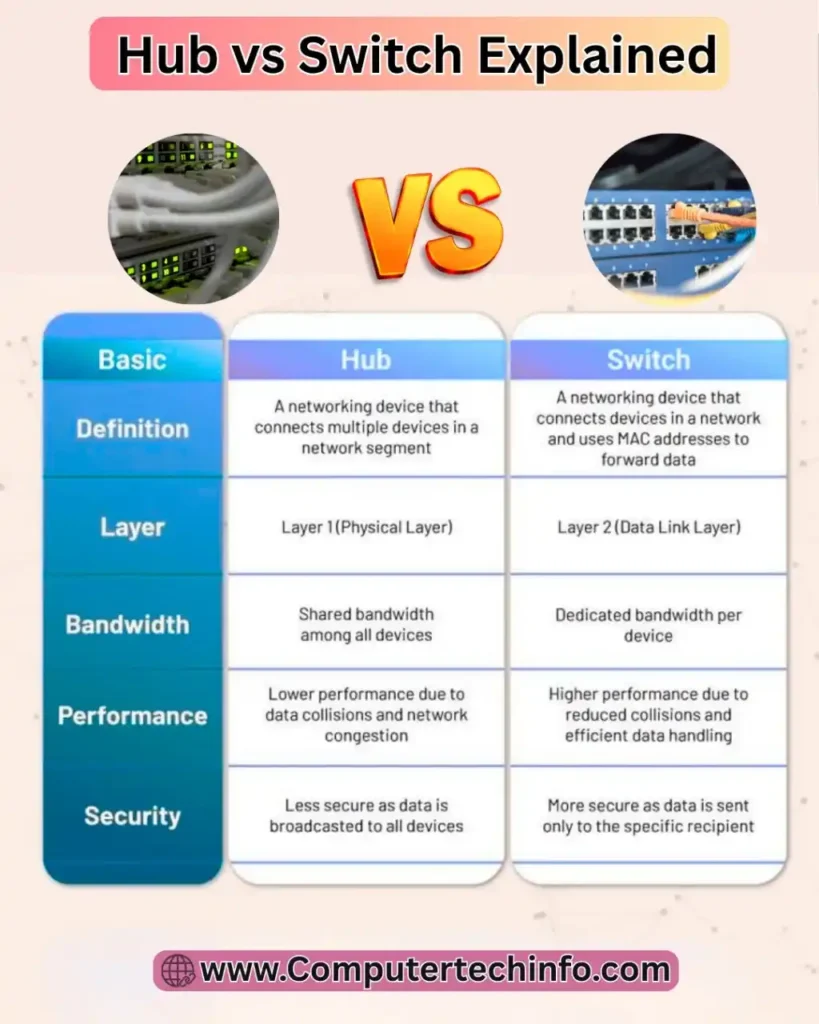In computer networks, several devices help connect and share data between systems. Among them, Hub and Switch are two key connectivity devices used alike data transmission. A hub is a basic device that sends data to all connected computers, anyway of the place.
In contrast, a switch is more intelligent it identifies each device’s MAC address and sends data only to the intended recipient. Understanding the difference between a hub and a switch is important like designing a secure and efficient network.

In this article, we’ll discuss the difference between a hub and a switch, two basic yet important devices used in computer networks. Even they may look alike; they work totally differently when it comes to handling and send data. Know how each device functions helps in building a faster, more effective, and secure network system.
What is Switch in Networking?
A switch is a smart networking device used to connect multiple computers or devices within the same network. It manages the flow of data efficiently by sending information only to the specific device it’s meant alike, secure faster and more secure communication.
A switch can be using to either start or stop the flow of current in a connection. When the switch is on (open), electricity or signals capable of pass between, permit the circuit to work. When the switch is off (closed), the move stops, and the circuit is disconnected, smash the connection.
A switch stores the addresses of all the devices attach to it in a special table. When data is sent around the network, the switch checks this table to find the exact device it’s meant like and sends the data only to that device. However, if the switch doesn’t accept the place address, it sends the data to all connected devices until it learns where the correct one is.
Types of Switch in Networking
There are four types of switches, such as:
Manageable switch is a type of switch that allows network manager to configure and control it. It comes with a console port and an IP address, which capable of to be assigned and adjusted to meet specific network needs. This builds it ideal like big or complex networks where monitoring and customization are important.
Unmanageable switch is simpler and does not allow any configuration. It has no console port and cannot be assigning an IP address. These switches are mostly used in small networks or home setups where easy plug and play usefulness is preferred.
LAN switch connect many devices in a Local Area Network (LAN), such as computers and printers in an office or company. It controls bandwidth speedy, securing that data packets do not clash or overlay, which enhance network speed and performance.
PoE switch (Power over Ethernet) is used in Gigabit Ethernet networks and provides both data and power between single cables. This reduces wiring clutter and is especially useful like devices like IP cameras, wireless entry points, and VoIP phones.
Applications of Network Switch
A switch is an essential networking device with few important applications that help improve communication and performance around a network.
It able to be create virtual LANs (VLANs) to divide a big network into smaller, manageable sections like better control and security.
The switch stores MAC addresses of connected devices to send data accurately to the right place.
It capable of also function as a multi-port bridge, linking multiple network segments and ensuring smooth data transfer.
Small offices commonly use switches to connect various devices and share internet or files efficiently.
A switch manages data flow to stop network crowding and ensure stable communication.
It helps physically connect devices like computers, printers, and servers within a network.
The switch supports both half-duplex and full-duplex modes like flexible data transmission.
Overall, it good secures, and fast communication between all connected devices.
Advantages and Disadvantages of Switch
Here are the Advantages and disadvantages of switches, including:
Advantages:
Switches help less network crowding by sending data only to the specific device that needs it, ensuring smoother communication.
They provide dedicated bandwidth to each port.
You capable of easily add more devices without important reconfiguration, building it simple to expand and scale your network as your organization grows.
Disadvantages
Switches are costly, especially those with advanced features and management options.
If a switch fails, all the connected devices may lose network access, disrupting communication.
Setting up and maintaining a switch requires skilled professionals, which capable of to be difficult like small organizations without a dedicated IT team.
What is Hub in Networking?
A hub is a basic networking device that connects multiple computers or devices through Ethernet ports. It usually connects to a router between an input port and provides many output ports like devices.

When a hub receives data, it broadcasts it to all connected devices, and the aim device picks out its own data. Hubs work in half-duplex mode, meaning them capable of any send or receive data at one time, but not both.
If two devices try to send data at the same time, a crash occurs, causing delays as both wait before trying again. Hubs function at Layer 1 (Physical Layer) of the OSI model and are generally used alike simple, small networks.
Types of Hubs
An active hub not only send data signals but also amplifies and regenerates them ago sending them to all connected devices. This helps maintain a strong and clear signal, even over longer distances, build it more effective than standard coaxial cable connections.
A passive hub simply forwards data packets to all connected devices without boosting or regenerating the signal. It doesn’t build up the connection and relies all on the connected network devices to maintain signal quality.
An intelligent hub, also known as a smart hub, includes advanced features such as network monitoring and diagnostics. It allows better control over data flow and traffic, build it easier to manage and troubleshoot network performance.
Uses for an Ethernet Hub
In modern networks, hubs have limited functions and are mainly used to connect multiple Ethernet devices into a single network. They are a simple and affordable option like small LAN setups where a router doesn’t have sufficient Ethernet ports.
Hubs are also cost-effective alike small networks with low data traffic, build them fit like basic connectivity needs.
Advantages and Disadvantages of Hub
There are some pros and cons, like as:
Advantages:
A hub allows easy network expansion by sharing internet bandwidth among connected devices.
It used like basic network monitoring to track connections and data flow.
Hubs are simple to use and offer backward similarity with older network systems.
They help extend the overall distance of a network by linking multiple devices together.
Hubs are inexpensive but not intelligent, as they simply broadcast data to all devices without filtering.
Disadvantages:
A hub works in half duplex mode, meaning data capable of only travel in one direction at a time.
It does not provide dedicated bandwidth, so all connected devices share the same data capacity.
A hub lacks the ability to choose the best path like data transmission.
It cannot differentiate between devices, sending data to all of them instead.
Hubs capable of only create small networks, suitable like limited connections.
They cannot filter data packets, meaning they can’t allow or block data based on source or place.
Most hubs come with only a few ports, usually between 4 and 12.
Key Differences Between Hub and Switch
| Hub | Switch |
| Works on the Physical Layer of the OSI model. | Works on the Data Link Layer of the OSI model. |
| Able to link many PCs in a single computer network. | Connects many devices in a network. |
| Send data as electrical signals or bits. | Send data as frames and packets. |
| Broadcasts data to all connected devices. | Firstly broadcasts, then performs unicast or multicast to the aim reciever. |
| Work in half duplex mode (one direction at a time). | Work in full duplex mode (both place at the same time). |
| Has one collision domain. | Number of collision domains number of ports. |
| Faces many data collisions. | No collisions occur in full-duplex mode. |
| Non-intelligent, does not use MAC addresses. | Intelligent, uses MAC addresses to send data |
| Does not store MAC addresses. | Stores MAC addresses in CAM (Content Addressable Memory) tables. |
| Passive device, doesn’t process data. | Active device, processes and forwards data intelligently. |
| Supports 10 Mbps transfer speed. | Supports 10/100 Mbps to 1 Gbps or high speeds. |
| Small flexibility and network size. | Highly flexibility, fit like big networks. |
| Simple and low-cost, but less effective. | Efficient and high-performing, even a little costly. |
FAQs (Frequently Asked Questions)
What is the Main Difference between Switch and Hub?
Main difference; hub is just able to send data to all connected devices. But, switch is able to directs data only to the specific device it’s meant for.
Which is Faster — Switch or Hub?
A switch works faster because it uses MAC addresses to identify the correct destination device, helping to reduce unnecessary network traffic.
Other side, a hub shares the same bandwidth across all its ports, which capable of lead to data collisions and slower network performance.
Is Switch More Expensive than Hub?
Yes! Switches are usually more expensive because they are smarter and more efficient in control network traffic. But, Hubs are cheaper but considered outdated like most modern networking needs.
Can We Replace Hub with Switch in Network?
Sure! You capable of and in fact, switches are favored over hubs because they offer faster show, less data collisions, and better network security.
Conclusion
Both hubs and switches play important roles in network message. But, they work in different ways. Hubs are simple and low cost devices, suitable like small networks, but they are less efficient because they broadcast data to all devices.
Switches, however, are faster, more efficient, and scalable; build them ideal like big networks with heavier traffic. The main differences between a hub and switch come down to network size, traffic control, and cost.



